By the VCCC project team.
The Libraries and Heritage Services (LHS): Connecting people to culture
What a hugely exciting and inspiring Visioning a Creative and Cultural County (VCCC) project conference we had on Tuesday 11 July 2023 at the University of Leicester! We were delighted to host over seventy attendees — including volunteers and participants, creative practitioners, cultural participation staff, strategic leaders, and academics to the event. It felt so gratifying to collectively share learning, engage in productive conversation and discussion, and network with each other in a wonderfully convivial and safe atmosphere. We explored the ways in which collaborative culture-based activity could inform how we design, structure and deliver the work of the Libraries and Heritage Services (LHS) to meet the needs of diverse, local communities across Leicestershire meaningfully and effectively.
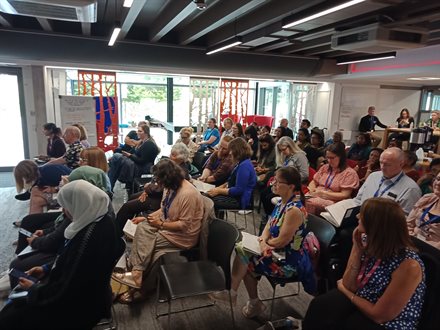 Some of the delegates at the VCCC Project conference
Some of the delegates at the VCCC Project conference
Amanda Hanton (Cultural Participation Team Manager), in the capacity of Master of Ceremonies (MC), excellently and expertly presided over the event. She warmly welcomed all event attendees and acknowledged Research England, University of Nottingham, Leicestershire County Council, Culture Leicestershire, Creative Leicestershire, and Arts Council England for supporting the event. In what followed, we watched a short film that described how LHS ‘delivers access to culture through collections, stories and expertise across a network of venues and in targeted programmes of activities within communities’.
It was interesting to learn that the network of venues spans museums, libraries, and resource centres in which programmes of activities range from access to art to archives and learning collections. Access and delivery of the activities is facilitated by a wide range of staff comprising curators, librarians, archivists, collections specialists, and learning and participation officers.
The film relayed to attendees that LHS works to shine light on hidden stories, connect people to arts and cultural objects, encourage people to find meaning and pleasure in reading, engage with history, invite people to challenge conventional ways of thinking, inspire creativity, generate enthusiasm, celebrate and commemorate, and support people to explore their local, regional, national, and international connections — past and present alike. A particularly important objective of LHS’ work has a three-fold dimension: (1) to connect with people who are new to LHS’ spaces, (2) to collaborate with people who have not seen themselves represented in LHS’ assets and services in the past, and (3) to invest in the creative practice of artists and creative practitioners working in collaboration with local communities to ensure that Leicestershire’s creative and cultural future can grow, thrive and be sustained.
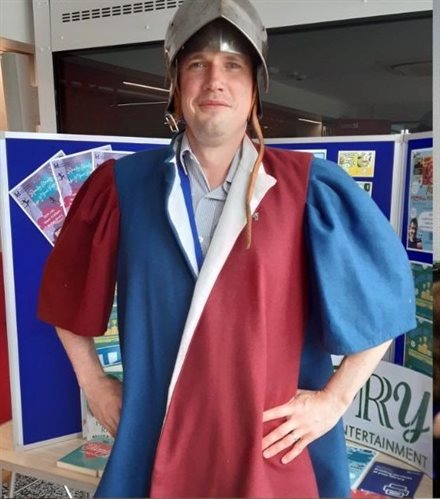 Tim Savage donning historical battlefield gear during re-enactment
Tim Savage donning historical battlefield gear during re-enactment
Following the film, Richard Knox, Tim Savage and Kirsty Ballard from the Cultural Participation Team at LHS presented some interesting performative acts. In addition to inviting attendees to contribute responses to factual questions posed in a fun way, Richard, Tim and Kirsty re-enacted selected historic events and personalities whose stories are preserved in some of the heritage assets, services and sites that operate under the umbrella of LHS.
Noteworthy heritage assets, services and sites operating under the stewardship of LHS across the county of Leicestershire include the following:
- Melton Carnegie Museum;
- Harborough Museum;
- Charnwood Museum;
- Bosworth Battlefield Heritage Centre and Country Park;
- Creative Learning Services;
- The 1620s House and Garden at Donnington le Heath;
- Museum Collections;
- Your Library; and
- The Record Office
Throughout the day, many attendees expressed the value in learning about the existence of these vital heritage assets, services and sites, and LHS’ stewardship of them.
Demonstrating acts of kindness and grace when telling untold and/or hidden stories
The great value of those assets, services and sites was made real and relatable to attendees by Jon Sleigh who held the keynote speech. A freelance arts educator, learning officer and learning curator by trade, Jon centred his speech on two key points: (1) embracing a shared space of kindness, togetherness and productivity, and (2) valuing our spaces, teams, relationships, and services in making Leicestershire better through culture. Picking up on some of the central themes relayed by the short film mentioned above, Jon’s speech was fascinating, inspiring and insightful from start to finish meaning there was a lot to take away.
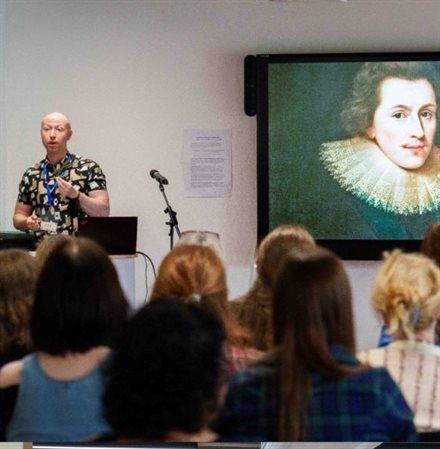 Jon Sleigh delivering his keynote speech
Jon Sleigh delivering his keynote speech
Three key points stood out to us the most. First, it is important to create opportunities and spaces to tell untold stories which, for a range of different reasons, have not always been told. Using the example of George Villiers (1592-1628), 1st Duke of Buckingham whose sexual orientation as a gay man is routinely erased from historical accounts about his personality, Jon made an impassioned plea for the importance of facilitating representation in collections held by public cultural organisations. In doing so, Jon observed, collections would fulfil one of their key remits as ‘a space for care’.
Second, as we tell stories — hidden or unhidden, it is crucial that we do so in collaboration and demonstrate acts of kindness and grace. Third, Jon noted that history is not locked in time. Using an image from The Record Office taken of boys after school foraging for coal in the canalised River Soar at West Bridge during the 1924 coal strike, Jon spoke of the desperation that compelled the boys to have to take whatever lumps of coal they could get hold of to take to their parents to be able to heat their homes. Jon drew comparisons to the impact of soaring energy prices, the cost-of-living crisis and other hardships today that make it very hard for some families to heat their homes. Can we speak of history repeating itself?
Co-producing a Cultural Strategy for LHS to ensure a future for cultural activity
Daniel Mutibwa (University of Nottingham) and Sophie Frost (University for the Creative Arts and University of Leicester) shared selected, key early-stage findings gathered so far. Visioning a Creative and Cultural County (VCCC) has taken a co-production approach to research that involves working with people, communities, groups and institutions with a stake in shaping and co-developing culture-based activity across Leicestershire. This approach is informing development of the Cultural Strategy through collective and democratic practice. To delimit the parameters of VCCC’s focus, programmes of activities undertaken by LHS and Creative Leicestershire are being analysed to identify what they are offering, how they are offering their provision, and how that provision could be best joined up to reap greater benefits. To this end, close engagement with a number of contextual factors has been very instructive in informing how data, evidence and information are being gathered.
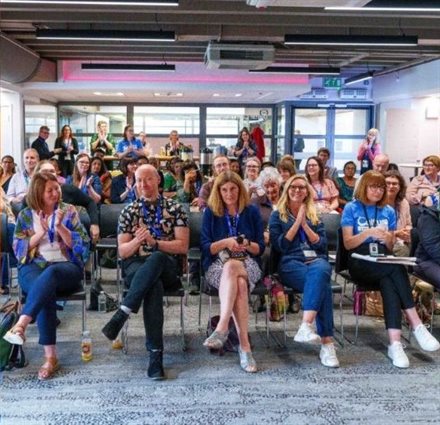 A view of some of the conference delegates from the front stage
A view of some of the conference delegates from the front stage
Among many other things, this includes (1) reviewing Cultural Strategies developed at selected county and district councils across the UK and further afield, (2) studying change and continuity characterising Leicestershire as a county, and (3) assessing the creative and cultural provision across the county — including mapping who the providers are and what uptake looks like.
Integral to this is an asset-based mapping exercise that is utilising strengths, relationships, talents, resources, and empowerment to co-create a shared plan for the future of collaborative culture-based activity across Leicestershire and beyond. It has become clear that the language used to describe this work, and how it will be presented in the Cultural Strategy, is going to be vitally important.
Whilst the Cultural Strategy is being written for Leicestershire County Council (LCC), its contents are going to be translated in formats and language appropriate for non-LCC audiences. Key VCCC outputs are going to be (1) the Cultural Strategy document, (2) an asset-mapping exercise document, and (3) a project report.
Improving economic growth, health and wellbeing, and learning through culture
LCC staff from different teams and units were invited to report on their work and where it sits within collaborative culture-based activity. Helen Harris (Economic Growth) presented on the role of culture in economic growth. One key point she made was that culture plays a pivotal role in improving people’s health and wellbeing, something that increases people’s productivity. This was the second time productivity was mentioned — after being introduced earlier as part of the central themes discussed in Jon Sleigh’s keynote speech. Kate Lister (Library Resources) highlighted the importance of libraries as key resources for local communities. She noted the role they play in improving learning and health and wellbeing and in encouraging people to explore, create and participate in creative and cultural activities in ways that may not be ordinarily available to them. Kate stressed the significance of listening to creative practitioners and valuing their talent and expertise — a point that Ruth Singer also made emphatically (see below).
Kath Parry (Creative Learning Services) introduced attendees to the innovative creative learning services programme that takes museum collections to schools and people’s homes, with a particular focus on pupils and people who are unable to access them. The activities of this multi-faceted programme stimulate reading for pleasure and creative learning. In the capacity of associate of Creative Leicestershire, Ruth Singer (Freelance Artist) talked about how the barriers caused by organisational hierarchies that artists face can be disempowering. She also spoke of the importance of paying artists fairly and promptly for their time and expertise, of validation, and of valuing creative practitioners as change makers.
Open-mindedness to volunteering and committing to shared values and behaviours
Lunch followed. Attendees looked around the marketplace where library, heritage and collections stands were on display and networked with both familiar and new people. Following lunch, The Anand Mangal Ladies performed a traditional dance after which attendees split in breakout groups to discuss and explore viable approaches to shaping the future of LHS’ collaborative culture-based work through the Cultural Strategy. In discussion of the role and remit of the Community Connectors Group, for example, volunteers and participants emphasised the significance of meeting and interacting with ordinary community members in local spaces where they engage in their everyday routines. Particularly community members who do not engage with creative and cultural provision should be prioritised. Volunteers and participants also identified the need to bring an open mind to volunteering — trying out new activities at their own pace and on their terms and conveying the value of volunteering to others who might have something to offer but may not know where and how to start.
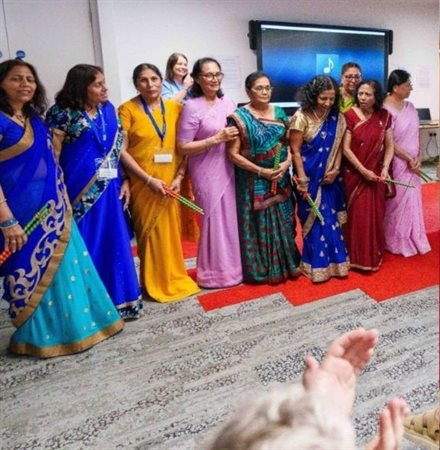 The Anand Mangal Ladies receiving applause following their performance
The Anand Mangal Ladies receiving applause following their performance
Cultural delivery staff pointed to the need to connect and link the Cultural Strategy to existing strategies of other teams and units as a way of joining up thinking and practice across LCC. Similarly interesting is devising effective ways of getting the aims and objectives of the Cultural Strategy out to local communities so as to harvest their contributions and input.
In their breakout group, creative practitioners worked towards a statement of values and behaviours that would be beneficial to artists and creatives working in partnership with organisations widely considered. Some of the attributes that creative practitioners bring to collaborative partnerships with organisations include emotions, ideas, curiosity, experience, new opportunities, resourcefulness, specialist skills and knowledge, original thinking, and, of course, creativity.
Other features that characterise partnerships in productive and mutually beneficial ways are shared practice, consultation, opportunity for feedback, realistic planning, and clear communication among others. A number of values that creative practitioners attach great importance to when working in partnership with organisations, local communities and other stakeholders include respect, empathy, collaboration, risk-taking, purpose, equality, integrity, responsibility, courage and gratitude.
Seeking inspiration externally, clear communication, and partnership working
Strategic leaders noted the importance of acknowledging that answers to critical questions may not always lie within LCC as an organisation, and that looking outside or externally instead might be helpful in search for inspiration, expertise and experiences. Clear communication was picked up again as essential in conveying to audiences outside LCC the work and services that LHS offers. Recognising the importance of various partnerships with district, borough and city council colleagues, local community partners, and volunteers in achieving shared objectives was highlighted as an important task that needs to be done right as is the need to craft clarity and focus through speaking with one voice and one message. An interesting point was made about data, for instance in the form of statistics and numbers, which may not always provide the answers needed, thereby making it challenging to develop persuasive and supporting arguments. A further crucial point revolved around the need to ensure that LHS provision continually reflects Leicestershire as it evolves as a county — now and in the future.
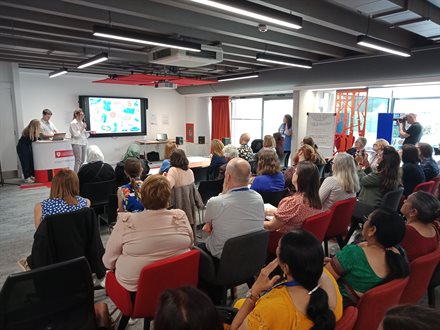 Indre Rimselyte introduces her animated art video
Indre Rimselyte introduces her animated art video
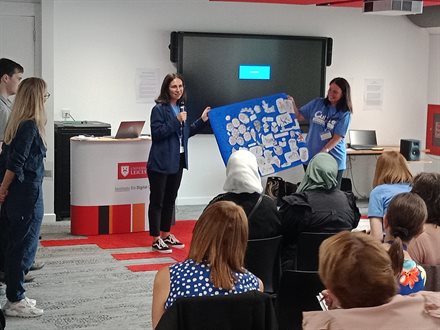 Kate Lugar speaks to her collage of artwork created during the event
Kate Lugar speaks to her collage of artwork created during the event
The concluding part of the event involved an invitation to attendees to share their thoughts and views on three questions in interactive fashion using a Mentimeter: (1) how attendees thought VCCC work will most impact on them, (2) how they thought VCCC work will benefit Leicestershire, and (3) one aspect they wanted to come from VCCC work. The responses were as interesting as they were informative. We will share them with project stakeholders via various project outputs over the course of the coming weeks and months. Below follows a selection of attendee feedback on the event and Mentimeter comments provided in response to the third question posed above
 A screenshot capturing delegate feedback on the event via social media
A screenshot capturing delegate feedback on the event via social media
If there was 1 thing you wanted to come from this event, what would it be?
Networking with people face-to-face to make creative things happen
More creative interactive events like today that result in [stakeholders knowing each other better] (a sense of Leicestershire cultural [stakeholders] being a family)
Recognition of the role culture plays in making Leicestershire a great place to live
A selection of Mentimeter responses provided by delegates
This was followed by a Q&A session during which the VCCC project team fielded questions relating to the scope of work currently being undertaken and details of next steps. Next came the presentation of two fascinating pieces of artwork that pulled together some of the overarching learning points discussed and shared throughout the day. The first was Doodle Art Reveal by Indre Rimselyte, and the second, collaborative art share by Kateryna (Katie) Lugar. Both pieces of artwork received resounding applause from attendees! Franne Wills (Head of LHS) concluded the event by reinforcing the powerfulness of togetherness, of showing kindness and grace in our interactions with each other, and of embracing collaboration in contributing to the improvement of creative and cultural activity across Leicestershire going forward.
Bringing together people who would not ordinarily share the same space at the same time to learn and share from each other in a friendly, warm and safe environment brought us greatest satisfaction!
Note: A version of this blog post first appeared on the Culture Leicestershire website at Leicestershire County Council.